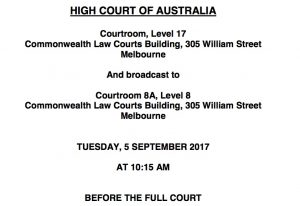The High Court’s current rectification works at its Canberra headquarters are said to be urgent, but foreseen. The Court could not have foreseen that they would coincide with a series of urgent, high profile cases that may determine the future of the present government. This week’s hearing into the legality of the same-sex marriage postal poll takes place in premises that have never before held a major hearing and are ill-suited to housing so many judges and barristers, let alone journalists and interested members of the public. The Court’s current Melbourne home, on Level 17 of the Commonwealth Courts building above Flagstaff Station, has just a single modest sized courtroom designed for special leave applications, and an even more modest lobby. The Federal Court warns its users:
It is anticipated that there will be delays through security screening at Commonwealth Law Courts building in Melbourne over the next few days. This is due to the High Court sitting in Melbourne over September and the expected increase in visitor numbers to the building. Please allow extra time for screening ahead of your court event.
The High Court’s contribution is to permit its hearing to be ‘broadcast to‘ a second courtroom on Level 8 of the same building, one usually used for Federal Court hearings (and the odd lecture.)
This isn’t a first – the Court has previously had overflow facilities for high profile cases such as the Gerard Baden-Clay appeal in Brisbane. An apparent first is the Court’s permission for live tweeting to occur in the overflow room, presumably because there is no possibility of the arguments being interrupted by a ringing phone. Video and audio recordings, and photographs, remain forbidden.
This week’s hearing is also a significant event in the history of the Court, which returns to its former home city in Melbourne for the first time in some 37 years. The last time the Court held a major hearing in Melbourne was in the Court’s former dedicated premises in Little Lonsdale St on 1st April 1980. Like this week, the litigation on that occasion involved a challenge to a federal executive decision, in that instance a 1977 federal government decision to allow the importation of two planes to service Tasmania’s freight market. The 1980 hearing concerned a damages claim by the importer against the challenger (Ansett) based on an injunction the High Court had briefly imposed on the importation. Ten months months later, a majority of the Court upheld Aickin J’s earlier ruling rejecting the damages claim, from their new Canberra home.
Suffice it to say that no-one in 1980 could have imagined that the Court’s next major hearing in Melbourne would involve a challenge to the validity of a nationwide opinion poll on same-sex marriage, much less one being brought on the grounds that such a poll is invalid as neither urgent, unforeseen or statistical, still less a challenge brought by representatives of Australia’s LGTBI community. While the result of the challenge is basically impossible to predict (though some, including me, have nevertheless tried), one thing is certain: that the High Court will issue its order upholding or dismissing the challenge more more speedily than it did in 1980. The order is quite likely to come this week, perhaps at the conclusion of Wednesday’s hearing. Following that order, the public’s interest will speedily switch to the poll or the parliament, depending on who wins. Followers of public law will probably have to wait a while longer for the Court’s reasons.

It depends on what you mean by major hearing. On 2-4 December 2008, the Court sat in Melbourne for the hearing of two appeals, again because of rectification works in Canberra. Stuart v Kirkland-Veenstra involved all justices except Kirby J.
Ooh. Thanks. My diligent research missed that!
“The last time the Court held a major hearing in Melbourne was in the Court’s former dedicated premises in Little Lonsdale St on 1st April 1980.”
Do you mean the Old High Court Building at 450 Little Bourke Street?
Sigh yes.